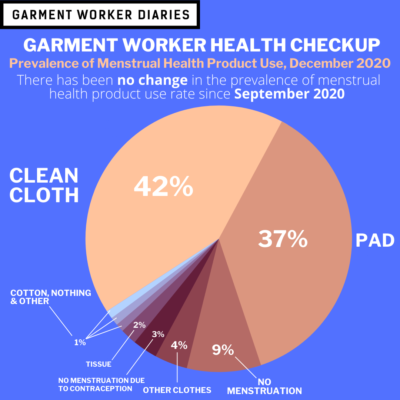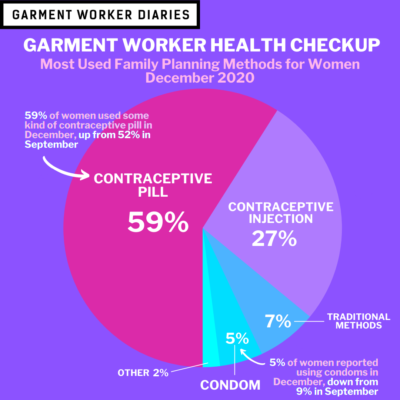MFO and SANEM have been paying close attention to the health of the garment workers in our study since the onset of the COVID-19 pandemic in Bangladesh. Every week we’ve asked respondents if they’ve been eating enough, if they’ve been ill or injured, and what steps if any they’ve taken to seek medical help. Last week we reported on these metrics for the month of December and put the results in the context of the preceding months in 2020. Please refer to that blog for the latest information on those metrics.
In September we also asked our female respondents specific questions about their family planning strategies and their menstrual health. We asked those same questions again in December. For this week’s blog we’ll update you on these health topics related to female garment workers. In addition, we will introduce a metric we will be tracking in the coming weeks: the share of workers who have reported being vaccinated against the coronavirus that causes COVID-19.
Family Planning and Menstrual Health
In order to ensure respondent comfort, we only presented family planning and menstrual health survey questions to female garment workers who also had female enumerators (there were not sufficient amounts of family planning data collected from men to conduct analysis).
Female respondents who have female enumerators represent 92% of the women in our study, and 99% of those women said they felt comfortable enough to answer the questions.
Family Planning
Among those female garment workers to whom family planning was applicable (i.e. they were married, of reproductive age and ability), 66% reported employing active family planning strategies, down from 71% in September, with the following breakdown:
- 59% used some kind of contraceptive pill in December, up from 52% in September
- 27% used some kind of contraceptive injection in December, statistically similar to the 30% in September
- 5% reported using condoms in December, down from 9% in September
- There was no change in rate of using “traditional methods”— 7% in both months
- Other responses, such as use of an IUD, permanent surgery, or implant were each used by less than 1% of applicable female respondents in both months
Among those respondents who practiced family planning, less than 1% said they had trouble purchasing or accessing family planning tools in the past three months.
Menstrual Health
There was no change in the share of menstrual health products used:
|
Menstrual Health Product |
Share Using, September |
Share Using, December |
|
Clean cloth |
44% |
42% |
|
Pad |
34% |
37% |
|
No menstruation |
7% |
9% |
|
No menstruation due to contraception |
5% |
3% |
|
Garments or other clothes |
3% |
4% |
|
Nothing |
3% |
1% |
|
Toilet tissue |
2% |
2% |
|
Other |
2% |
1% |
|
Cotton |
1% |
1% |
Among those respondents whose preferred menstrual health product was a pad, 99% said they had no trouble accessing pads over the past month.
COVID-19 Vaccine Awareness
In early January we asked workers the following question:
“A vaccine is a substance that helps protect against certain diseases. Has a vaccine been developed for COVID-19?”
45% answered “yes.”
As a follow up, for those that answered “yes” we said:
“You are right! A vaccine has been developed for COVID-19 that reduces the likelihood that you would get COVID-19.
For the other 55% who answered “No” we said:
“In fact, a vaccine has been developed for COVID-19 that reduces the likelihood that you would get COVID-19.
The purpose of this question and the follow-ups was two-fold. First, we wanted to measure the level of awareness among workers of the development of a COVID-19 vaccine and we wanted to do so in a way that did not give away the answer—hence the direct question about the vaccine’s existence. Second, we wanted to make all workers aware that there is a vaccine so that we could track whether they had received the vaccine or not. We will be asking them if they have been vaccinated every week and reporting the results regularly here.
The family planning and menstrual health data come from a pool of 886 female workers in September and 901 in December, of whom 875 and 895 respectively indicated their comfort with answering the questions. The vaccine awareness questions were asked of 1,291 workers in early January. These workers are employed in factories spread across the five main industrial areas of Bangladesh (Chittagong, Dhaka City, Gazipur, Narayanganj, and Savar). Just over three-quarters of the working respondents are women, roughly representative of workers in the sector as a whole.


